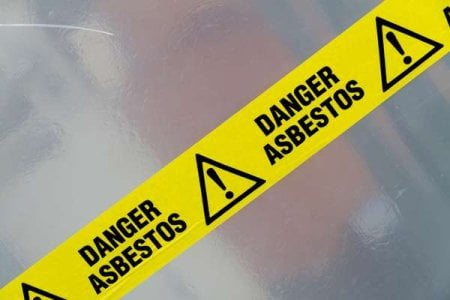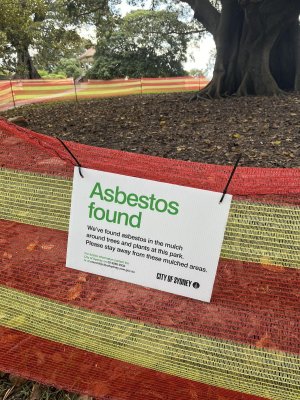Scared of the asbestos health threat? Expert shares advice on how to stay safe
By
Seia Ibanez
- Replies 4
Asbestos contamination is a growing concern for Australians, with over 50 sites across New South Wales (NSW) now identified as being affected.
This issue is particularly alarming for the more than five million residents of Sydney, where asbestos has been detected in topsoil at schools, hospitals, and parks.
The first discovery of asbestos was at Rozelle Parklands playground on 10 January.
The latest sites to return positive results are a construction site at The Children's Hospital at Westmead, Bicentennial Park in Glebe, and Oran Park Fire Station.
The affected areas have been cordoned off, with 'possible asbestos' notices attached.

According to the NSW Environment Protection Authority (EPA), the total number of sites that have tested positive has climbed to 54 as of Thursday, 22 February.
While the presence of asbestos is undoubtedly concerning, Professor Sonja Klebe from Flinders University's College of Medicine and Public Health assured that the risk of falling ill is low.
‘We all have a level of background exposure. What happens is if you get anything above that, then that increases your risk,’ Klebe said.
Homes and buildings constructed from the 1940s to the 1980s often have asbestos.
Even today, about one out of every three homes in Australia still contains asbestos, as reported by the Asbestos and Silica Safety and Eradication Agency.
'If asbestos isn't disturbed, the risk is very low,’ Klebe added.
Klebe’s statement echoed Peter Franklin, Associate Professor and Director of Occupational Respiratory Epidemiology at the University of Western Australia.
According to Franklin, the most important factor for disease risk is exposure—you actually have to inhale fibres to be at risk of disease.
‘For those who accessed the contaminated areas, the level of exposure will depend on disturbing the asbestos and how many fibres become airborne due to that disturbance,’ he said. You can read more about his article here.
If you suspect you've been exposed to asbestos, Klebe urged ‘not to panic’ as the risk of illness from brief exposure is low. However, it's important to log any potential contact with the National Asbestos Exposure Register.
This allows for the tracing back of any related illness, as symptoms from asbestos exposure can take up to 30 years to appear. Klebe said that this is one of the reasons why it’s difficult to track what people are exposed to.
She also noted that children playing in contaminated mulch may be at a higher risk, given the long latency period of asbestos-related diseases.
‘The risk of getting sick is proportional to the type of fibre, and we don't know which type that is,' she said.
'Exposure earlier on in life is thought to be more significant given it's on average 30 years before any symptoms show.’
Symptoms of asbestos exposure include breathlessness and chest pain. An X-ray may show a build-up of fluid in the lung.
People who develop lung cancer due to exposure to asbestos typically live for about one year on average after being diagnosed.
NSW Premier Chris Minns has acknowledged the 'big problem' of the asbestos crisis, with the EPA currently investigating the situation.
He said it’s a ‘serious offence’ and the ‘fines are up to $2 million’.
He assured the community that while the contamination is concerning, the risk is not as severe as if the asbestos fibres were airborne.
‘This is bonded asbestos, it's not safe, and we don't want it in our community, but the risk is not as serious as if you had asbestos fibre in your backyard,’ Premier Minns said.
Professor Klebe suggested that authorities should be measuring air quality to assess asbestos levels and ensure public safety.
‘You wouldn't want it in a playground, but if it's just on the ground and it's not disturbed, it's probably going to have little effect,' she said.
'The chances of getting sick are extremely small, you don't want people to panic, but we're going to have a big problem for a long time.’
The ongoing investigation by the NSW EPA aims to determine the source of the affected mulch.
GreenLife Resource Recovery Facility, a suspected source, denies responsibility for the asbestos issue.
The company's general manager, Domenic Vitocco, insisted that his company is not to blame, adding that it has ‘been made a scapegoat’ by the state government.
'All the testing from the EPA has come back from our yard clean. Our testing has come back clear, and we're a little bit puzzled as to how this is all happening,' he said.
'During the investigation, I can't really talk too much, but what I do know is that a number of these sites are major remediation sites...but I can't comment further.’
If you experience these symptoms and have a history of asbestos exposure, seek medical attention immediately.

Stay vigilant and take note of these sites in your area and remain cautious of potential hazards of asbestos.
This issue is particularly alarming for the more than five million residents of Sydney, where asbestos has been detected in topsoil at schools, hospitals, and parks.
The first discovery of asbestos was at Rozelle Parklands playground on 10 January.
The latest sites to return positive results are a construction site at The Children's Hospital at Westmead, Bicentennial Park in Glebe, and Oran Park Fire Station.
The affected areas have been cordoned off, with 'possible asbestos' notices attached.

There has been a growing concern for the rise of asbestos-positive sites in NSW. Credit: Shutterstock
According to the NSW Environment Protection Authority (EPA), the total number of sites that have tested positive has climbed to 54 as of Thursday, 22 February.
While the presence of asbestos is undoubtedly concerning, Professor Sonja Klebe from Flinders University's College of Medicine and Public Health assured that the risk of falling ill is low.
‘We all have a level of background exposure. What happens is if you get anything above that, then that increases your risk,’ Klebe said.
Homes and buildings constructed from the 1940s to the 1980s often have asbestos.
Even today, about one out of every three homes in Australia still contains asbestos, as reported by the Asbestos and Silica Safety and Eradication Agency.
'If asbestos isn't disturbed, the risk is very low,’ Klebe added.
Klebe’s statement echoed Peter Franklin, Associate Professor and Director of Occupational Respiratory Epidemiology at the University of Western Australia.
According to Franklin, the most important factor for disease risk is exposure—you actually have to inhale fibres to be at risk of disease.
‘For those who accessed the contaminated areas, the level of exposure will depend on disturbing the asbestos and how many fibres become airborne due to that disturbance,’ he said. You can read more about his article here.
If you suspect you've been exposed to asbestos, Klebe urged ‘not to panic’ as the risk of illness from brief exposure is low. However, it's important to log any potential contact with the National Asbestos Exposure Register.
This allows for the tracing back of any related illness, as symptoms from asbestos exposure can take up to 30 years to appear. Klebe said that this is one of the reasons why it’s difficult to track what people are exposed to.
She also noted that children playing in contaminated mulch may be at a higher risk, given the long latency period of asbestos-related diseases.
‘The risk of getting sick is proportional to the type of fibre, and we don't know which type that is,' she said.
'Exposure earlier on in life is thought to be more significant given it's on average 30 years before any symptoms show.’
Symptoms of asbestos exposure include breathlessness and chest pain. An X-ray may show a build-up of fluid in the lung.
People who develop lung cancer due to exposure to asbestos typically live for about one year on average after being diagnosed.
NSW Premier Chris Minns has acknowledged the 'big problem' of the asbestos crisis, with the EPA currently investigating the situation.
He said it’s a ‘serious offence’ and the ‘fines are up to $2 million’.
He assured the community that while the contamination is concerning, the risk is not as severe as if the asbestos fibres were airborne.
‘This is bonded asbestos, it's not safe, and we don't want it in our community, but the risk is not as serious as if you had asbestos fibre in your backyard,’ Premier Minns said.
Professor Klebe suggested that authorities should be measuring air quality to assess asbestos levels and ensure public safety.
‘You wouldn't want it in a playground, but if it's just on the ground and it's not disturbed, it's probably going to have little effect,' she said.
'The chances of getting sick are extremely small, you don't want people to panic, but we're going to have a big problem for a long time.’
The ongoing investigation by the NSW EPA aims to determine the source of the affected mulch.
GreenLife Resource Recovery Facility, a suspected source, denies responsibility for the asbestos issue.
The company's general manager, Domenic Vitocco, insisted that his company is not to blame, adding that it has ‘been made a scapegoat’ by the state government.
'All the testing from the EPA has come back from our yard clean. Our testing has come back clear, and we're a little bit puzzled as to how this is all happening,' he said.
'During the investigation, I can't really talk too much, but what I do know is that a number of these sites are major remediation sites...but I can't comment further.’
If you experience these symptoms and have a history of asbestos exposure, seek medical attention immediately.
Key Takeaways
- Over 50 sites across NSW, including schools and hospitals, are contaminated with asbestos.
- Expert advice suggested the risk of illness from asbestos exposure is low if the material is not disturbed.
- Symptoms of asbestos-related illnesses may not appear for 30 years, with breathlessness and chest pain being common initial signs.
- Authorities are still investigating the source of the asbestos contamination while emphasising the lower risk associated with bonded fibres.
Last edited:








